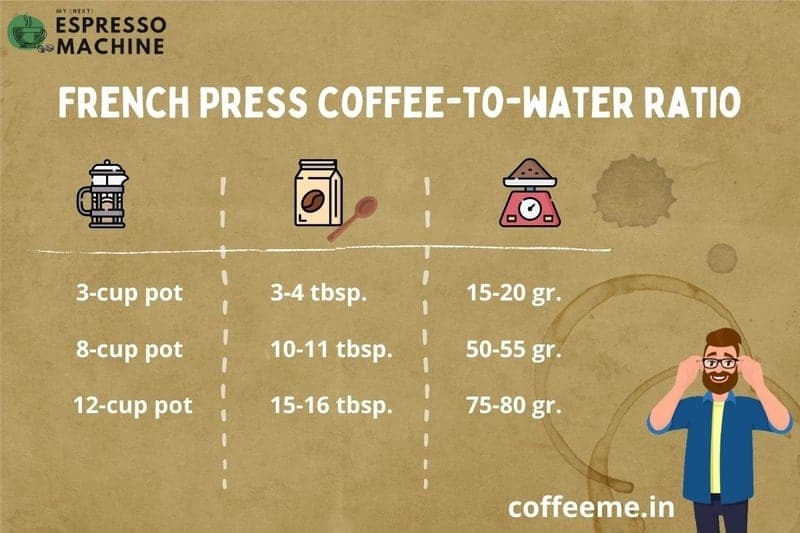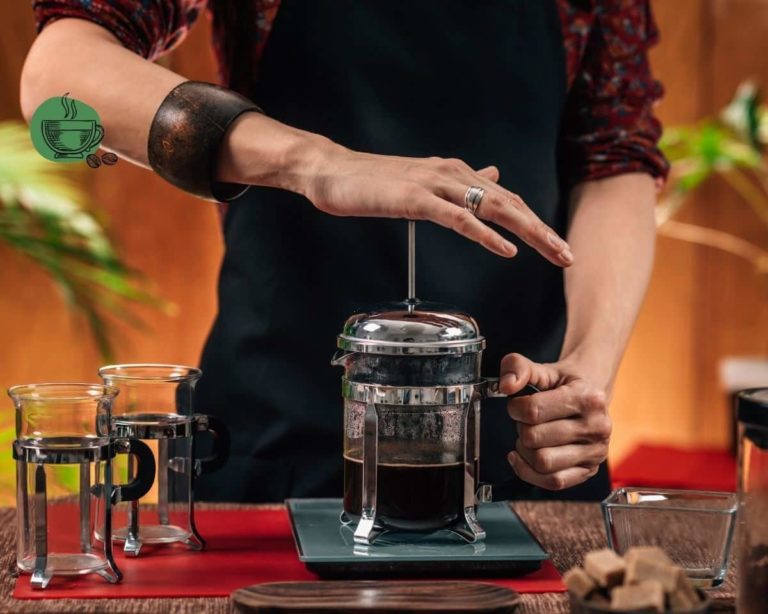In short: The French Press coffee-to-water ratio should be about a heaped tablespoon to 3 oz of water. If you are using a 3-cup pot, use 3-4 tablespoons of coffee.
Now let’s uncover some more secrets on how to use a French Press.
What is a French Press?
A French press is a coffee maker typically made of glass or metal. This coffee brewing method consists of a beaker, a lid with a filter, and a plunger.
A French press differs from regular coffee makers because it does not filter the coffee grounds. After brewing, the grounds remain in the beaker and can be seen as sediment on top of the cup. This method differs from typical drip-style coffee makers, which use paper filters to separate the grounds from the brewed coffee.
The French press was invented in 1929 by an Italian designer named Attilio Calimani. He called it “the espresso machine for home use.”
What is the best coffee-to-water ratio for a french press?
As mentioned earlier, the best water:coffee ratio is one heaped tablespoon to 3 oz of water. If you are using a 3-cup pot, use 3-4 tablespoons of coffee.
The french press coffee ratio is slightly different from the pour-over or Moka-pot coffee ratios. The french press coffee ratio is typically 17 grams of ground coffee to 1 liter of water. In comparison, the pour-over coffee ratio generally is 60 grams of ground coffee to 500 milliliters of water.

The water-to-coffee ratio for a french press is different from that of a pour-over because the french press has a metal mesh filter that retains some sediment and oils. This means you need fewer grounds to achieve the same strength as you would with a pour-over.
The ratio of coffee to water will vary depending on a few different factors:
- The first factor is the type of coffee you are using. If you use light roasted coffee, the ratio should be higher. If you use dark-roasted coffee, the ratio should be lower.
- The second factor is how finely ground your coffee beans are. If your beans are finely ground, the ratio should be lower because there is less surface area for water to soak in and extract flavor.
- The third factor is how long you want your brew to steep. The longer it steeps, the lower the ratio should be because more water will have time to extract flavor from your beans and dissolve into your cup of joe.
How to Use a French Press – Preparing the Perfect Cup of Coffee
The French press is a prevalent coffee brewing method, and it’s easy to do. You’ll need coffee, water, and of course, the pot itself.
Step 1: Fill the pot about halfway with warm water. When the pot feels warm – dispose of the water to the sink. This will help preheat the glass surface to prevent heat shock, plus – it will keep your coffee warm.
Step 2: Measure out the right amount of ground coffee beans for your pot size (see above), and pour them into the bottom of the pot.
Step 3: Pour boiling water just up to the coffee grounds level. If you use freshly ground coffee, you’ll notice some foam floating above your coffee. This foam results from the “blooming” process, which helps release additional flavors in your cup of coffee.
After 30-60 seconds, fill the pot with more boiling water and stir using a wooden spoon. Using a wooden spoon protects the delicate glass of the french press pot.
Step 4: Allow the coffee to sit for 4 minutes before pressing down on the plunger.
Step 5: Pour the coffee to enjoy your freshly brewed cup of French-press coffee. You don’t want the coffee to sit in the pot for long, as the grounds and the water are not separated. The coffee will get stronger if you wait too long before drinking it.
The used coffee grounds will go to your trash can or compost bin, never into the sink! There are so many ways to recycle used coffee grounds!

The best coffee for a french press
A French press requires coarse-ground coffee to get the best flavor. The grind’s coarseness affects how quickly the water will seep through to extract all of the flavors from your coffee grounds. The grind size should be similar to sea salt.
The grind size determines how much flavor will be extracted from your grounds, so choosing one that will suit your tastes is crucial! If you want more flavor, go for a coarser grind. Otherwise, go for finer grounds. When pressing down your plunger, if it feels “stuck,” it means your coffee is too finely ground and gets stuck between the plunger and the pot walls. Your coffee is probably too coarse if you don’t feel resistance while pushing the plunger down.
The best coffee for a french press has a high concentration of flavor. It should also have an even roast profile, ensuring the coffee is not too bitter or too acidic. The most popular and widely-used coffee beans are Arabica and Robusta beans. Arabica beans have a higher acidity level, while Robusta beans have a higher caffeine level, so they both have advantages.
The Best Brands of French Presses
Many brands manufacture french press pots. Check out Bodum, Chemex, Espro, Frieling, Hario, and Melitta.
Check out one of the classic models:
How to Choose the Right Size of pot for your needs?
The size of a French press is measured by the number of cups it can hold, but there’s a little math to it. The actual number of coffee mugs you get from your pot is about half of the number of cups it contains.
The most popular size is the 8-cup French Press. It means it’s excellent for getting about 4 coffee mugs at a time. There are smaller pots of 3-4 cups and larger ones of 12 cups, but the 8-cup size is excellent for most users.
How to Clean a French Press
Cleaning a French Press is not the most challenging task in the world. But it does require some patience and care.
Step 1: First, pour out all of the coffee grounds left in your pot. The used coffee grounds go to your trash can or compost bin, not into the sink! You can use a spoon or some paper towel to get them out.
Step 2: Rinse the pot with cold water. This will remove any grit that may have gotten in when the coffee was ground.
Step 3: Fill the French press with warm water and add a few drops of dish soap. The dish soap will help break up any oils or dirt stuck inside the pot.
Step 4: Use a small brush to scrub off any remaining coffee stains or residue from each part of your French press – this includes the inside walls.
Step 5: Rinse off all soap residue with hot water and let it dry before putting the lid back on it and storing it away for later use.
Tip from the Expert
The used coffee grounds go to your trash can or compost bin, never into the sink!
Conclusion
I hope this article has given you a better understanding of the benefits of using a French Press for brewing coffee and tea. A French Press is an excellent choice because it has an easy-to-use, simplistic design that brews rich, flavorful coffee and tea with just the right amount of pressure.
A French press is a fantastic way to make coffee at home. The coffee produced from a French press is rich and flavorful with a medium to full body. It can also be used to make tea, hot cocoa, or any other drink you prefer if you don’t like coffee.
French press FAQs
We recommend using 1 rounded tablespoon of coffee for every 3-4 ounces of water.

French presses come in various sizes, from small single-serve presses to large carafe-style presses.
The most popular size is the 8-cup press, which makes enough coffee for 2-3 people. However, French presses are also available in 12-cup and even 32-cup sizes.
A larger press may be better if you entertain frequently or have a large family.
The pressure created by this process is less than that of an espresso machine but more than that of other types of stovetop coffee makers.
Many brands manufacture french press pots. Check out Bodum, Chemex, Espro, Frieling, Hario, and Melitta if you’re about to buy a french press.
Most of the good pots are usually stainless steel, glass, or durable plastic.
Please note that not all beans are created equal. You want to look for the darkest roast to ensure that your coffee will have a dark, rich flavor. The most popular and widely-used coffee beans are Arabica and Robusta beans. Arabica beans have a higher acidity level, while Robusta beans have a higher caffeine level, so they both have advantages.
The cleaning process is not the most challenging task in the world. But, it does require some patience and care.
Step 1: The first step is to pour out all of the coffee grounds left in the pot. The used coffee grounds go to either your trash can or compost bin, not into the sink! You can use a spoon or some paper towel to get them out.
Step 2: Rinse the pot and othe parts with cold water. This will remove any grit that may have gotten in when the coffee was ground.
Step 3: Fill the pot with warm water and add a few drops of dish soap. The dish soap will help break up any oils or dirt stuck to the inside of the pot.
Step 4: Use a small brush to scrub off any remaining coffee stains or residue from each part of your French press – this includes the inside walls.
Step 5: Rinse off all soap residue with hot water and let it dry before putting the lid back on it and storing it away for later use.
The most popular size is the 8-cup French Press. The size of the pot is measured by the number of cups it can hold, but there’s a little math to it. The actual number of coffee mugs you get from your French press is about half of the number of cups it contains.
Allow the coffee to sit for 4 minutes before pressing down on the plunger. You don’t want the coffee to sit in the french press pot for a long time, as the grounds and the water are not separated. The coffee will get stronger if you wait too long before drinking it.
yes, stir the coffee using a wooden spoon. Using a wooden spoon protects the delicate glass of the pot.
Use coarse ground coffee to get the best flavor. The grind’s coarseness affects how quickly the water will seep through to extract all of the flavors from your coffee grounds. The grind size should be similar to sea salt.
Use the french-press as you would using freshly ground coffee beans. The “blooming” process might not be as effective with pre-ground coffee if it had been exposed to air.
Just pour coarsely ground coffee into the carafe and add cold water. The key to a delicious cold brew is patience. You’ll have to let the coffee steep in the water for at least 12 hours, but you’ll be rewarded with a rich, sweet coffee that’s perfect for iced-coffee
How to use a french press (video):
This video by Bodum, shows you how to do it right. You can get their Chambord model here.



